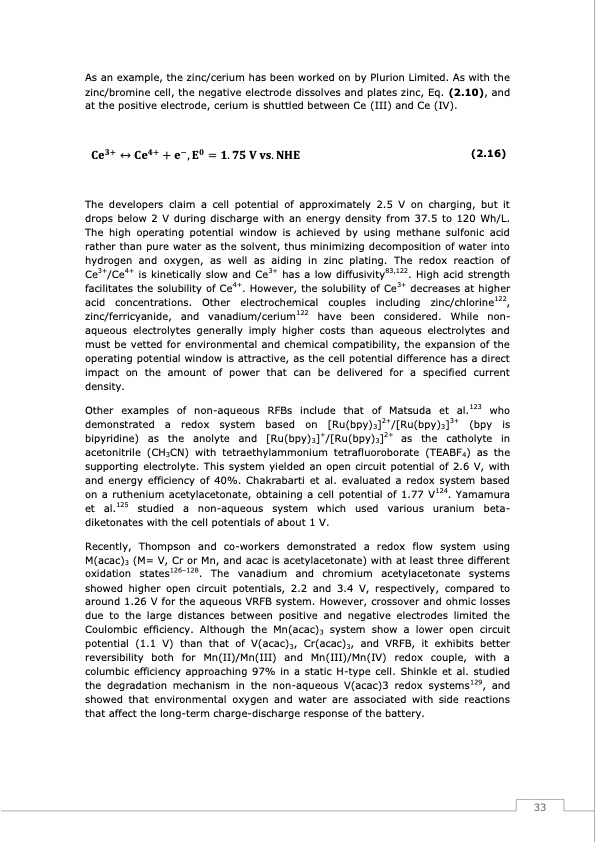
PDF Publication Title:
Text from PDF Page: 034
As an example, the zinc/cerium has been worked on by Plurion Limited. As with the zinc/bromine cell, the negative electrode dissolves and plates zinc, Eq. (2.10), and at the positive electrode, cerium is shuttled between Ce (III) and Ce (IV). (2.16) The developers claim a cell potential of approximately 2.5 V on charging, but it drops below 2 V during discharge with an energy density from 37.5 to 120 Wh/L. The high operating potential window is achieved by using methane sulfonic acid rather than pure water as the solvent, thus minimizing decomposition of water into hydrogen and oxygen, as well as aiding in zinc plating. The redox reaction of Ce3+/Ce4+ is kinetically slow and Ce3+ has a low diffusivity83,122. High acid strength facilitates the solubility of Ce4+. However, the solubility of Ce3+ decreases at higher acid concentrations. Other electrochemical couples including zinc/chlorine122, zinc/ferricyanide, and vanadium/cerium122 have been considered. While non- aqueous electrolytes generally imply higher costs than aqueous electrolytes and must be vetted for environmental and chemical compatibility, the expansion of the operating potential window is attractive, as the cell potential difference has a direct impact on the amount of power that can be delivered for a specified current density. Other examples of non-aqueous RFBs include that of Matsuda et al.123 who demonstrated a redox system based on [Ru(bpy)3]2+/[Ru(bpy)3]3+ (bpy is bipyridine) as the anolyte and [Ru(bpy)3]+/[Ru(bpy)3]2+ as the catholyte in acetonitrile (CH3CN) with tetraethylammonium tetrafluoroborate (TEABF4) as the supporting electrolyte. This system yielded an open circuit potential of 2.6 V, with and energy efficiency of 40%. Chakrabarti et al. evaluated a redox system based on a ruthenium acetylacetonate, obtaining a cell potential of 1.77 V124. Yamamura et al.125 studied a non-aqueous system which used various uranium beta- diketonates with the cell potentials of about 1 V. Recently, Thompson and co-workers demonstrated a redox flow system using M(acac)3 (M= V, Cr or Mn, and acac is acetylacetonate) with at least three different oxidation states126–128. The vanadium and chromium acetylacetonate systems showed higher open circuit potentials, 2.2 and 3.4 V, respectively, compared to around 1.26 V for the aqueous VRFB system. However, crossover and ohmic losses due to the large distances between positive and negative electrodes limited the Coulombic efficiency. Although the Mn(acac)3 system show a lower open circuit potential (1.1 V) than that of V(acac)3, Cr(acac)3, and VRFB, it exhibits better reversibility both for Mn(II)/Mn(III) and Mn(III)/Mn(IV) redox couple, with a columbic efficiency approaching 97% in a static H-type cell. Shinkle et al. studied the degradation mechanism in the non-aqueous V(acac)3 redox systems129, and showed that environmental oxygen and water are associated with side reactions that affect the long-term charge-discharge response of the battery. 33PDF Image | Redox Flow Batteries Vanadium to Earth Quinones

PDF Search Title:
Redox Flow Batteries Vanadium to Earth QuinonesOriginal File Name Searched:
FJVG_TESIS.pdfDIY PDF Search: Google It | Yahoo | Bing
Salgenx Redox Flow Battery Technology: Salt water flow battery technology with low cost and great energy density that can be used for power storage and thermal storage. Let us de-risk your production using our license. Our aqueous flow battery is less cost than Tesla Megapack and available faster. Redox flow battery. No membrane needed like with Vanadium, or Bromine. Salgenx flow battery
| CONTACT TEL: 608-238-6001 Email: greg@salgenx.com | RSS | AMP |